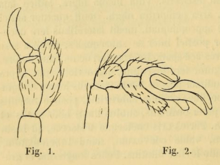Seycellesa
Seycellesa is a genus of spiders in the family Theridiidae. It consists of only its type species: Seycellesa braueri, which is endangered and endemic to the Seychelles.
| Seycellesa | |
|---|---|
 | |
| S. braueri | |
| Scientific classification | |
| Kingdom: | Animalia |
| Phylum: | Arthropoda |
| Subphylum: | Chelicerata |
| Class: | Arachnida |
| Order: | Araneae |
| Infraorder: | Araneomorphae |
| Family: | Theridiidae |
| Genus: | Seycellesa Koçak & Kemal, 2008[1] |
| Type species | |
| Theridion braueri Simon, 1898 | |
| Species | |
| |
| Synonyms[2] | |
Genus:
| |
Taxonomic history
The type species was initially described in 1898 by the French naturalist Eugène Simon, who placed it in the genus Theridion. He chose the specific epithet braueri to honor A. Brauer at the University of Marburg. His description was based on a male specimen.[5]
British arachnologist Michael Roberts described a junior synonym, T. purifum, in 1978. The specific name was described as "an arbitrary combination of letters". His description was based on a female specimen.[4] Michael Saaristo synonymized T. purifum with T. braueri in 1999.[6]
In 2006, Saaristo circumscribed a new genus for T. braueri. He named it Robertia after Michael Roberts.[3] However, that generic name was invalid due to a senior homonym: the synapsid genus Robertia. In 2008, Ahmet Koçak and Muhabbet Kemal created a nomen novum for this genus: Seycellesa.[1]
Distribution
S. braueri is endemic to the Seychelles, where it is found on the islands of Mahé and Silhouette[3] at elevations of 300 to 500 m (980 to 1,640 ft).[7] The type locality for S. braueri is Mahé;[5] the type locality for the junior synonym S. purifum is Morne Seychellois, central Mahé.[4] Its habitat is woodland.[7]
Species description
The total length of the female S. braueri is 6.5 mm (0.26 in); males are smaller,[8] with a length of 2.5 mm (0.098 in).[5] The carapace is yellow-orange in color and has a dark border and marking along its median. The color of the chelicerae, maxillae, labium, and sternum is black-tinted yellow. The opisthosoma is spherical and the chelicerae have two anterior teeth.[8]
Conservation status
The IUCN Red List considers S. braueri to be endangered. Its habitat is deteriorating due to invasive plants like Cinnamomum verum. Its extent of occurrence is 300 km2 (120 sq mi) and its area of occupancy is 50 km2 (19 sq mi).[7]
References
- Koçak, Ahmet Ö.; Kemal, Muhabbet (2008). "New synonyms and replacement names in the genus group taxa of Araneida". Centre for Entomological Studies Ankara, Miscellaneous Papers. 139–140: 4.
- "Gen. Seycellesa Koçak & Kemal, 2008". World Spider Catalog. Natural History Museum Bern. Retrieved 18 February 2018.
- Saaristo, Michael I. (2006). "Theridiid or cobweb spiders of the granitic Seychelles islands (Araneae, Theridiidae)" (PDF). Phelsuma. 14: 70–74.
- Roberts, Michael (1978). "Theridiidae, Mysmenidae and gen. Theridiosoma (Araneidae) (Araneae)". Revue Zoologique Africaine. 92 (4): 909–913.
- Simon, E. (1898). "Arachnides recueillis en 1895 par M. le Dr A. Brauer (de l'Université de Marburg) aux îles Séchelles". Annales de la Société Entomologique de France. 66 (2–3): 376–377.
- Saaristo, M. I. (1999). "An arachnological excursion to the granitic Seychelles, 1–26th January 1999. Arachnid species lists for Silhouette, Cousine & Mahé". Phelsuma. 7 (Supplement A): 10. ISSN 1026-5023.
- Gerlach, J. (2014). "Robertia braueri". IUCN Red List of Threatened Species. 2014: e.T196490A2458812. doi:10.2305/IUCN.UK.2014-1.RLTS.T196490A2458812.en.
- Saaristo, Michael I. (2010). "Order Araneae Clerck, 1757 spiders". In Gerlach, Justin; Marusik, Yuri (eds.). Arachnida and Myriapoda of the Seychelles Islands. Manchester: Siri Scientific Press. pp. 263–264. ISBN 978-0-955-8636-8-4.